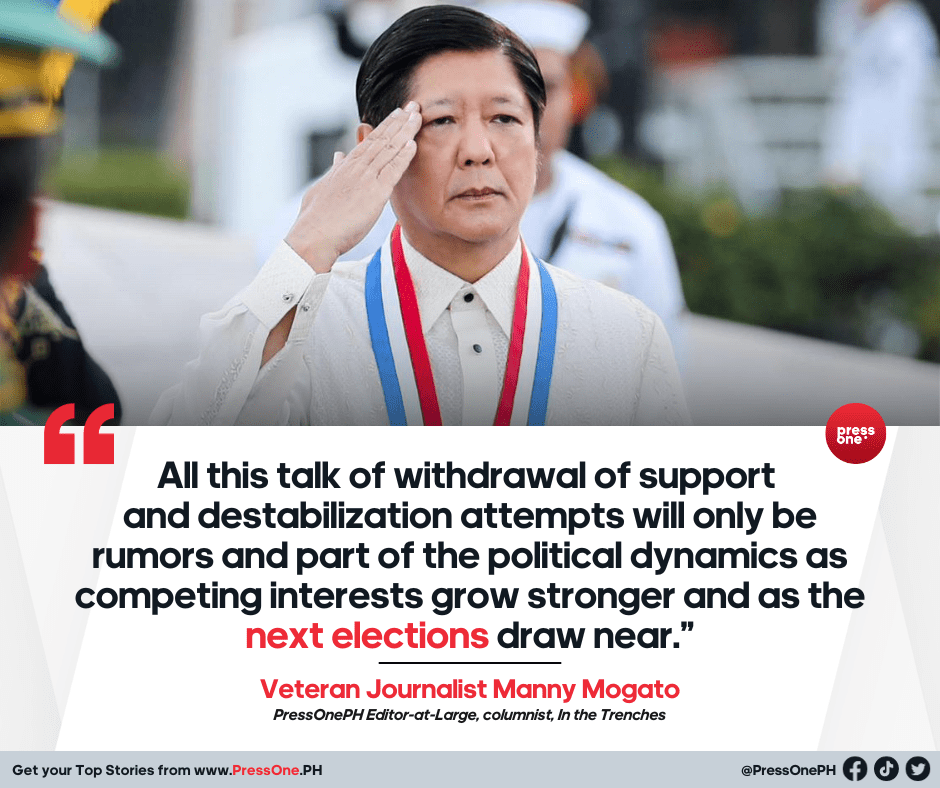
A few days before the year ended, there was a post on YouTube about two former military officers calling for other retired soldiers and police officers to withdraw support from President Ferdinand Marcos Jr. on the issue of incompetence and corruption.
However, no evidence was presented, and instead, a litany of baseless, defamatory, and seditious statements were hurled by the disgruntled ex-soldiers.
Then one of the talking heads on the YouTube vlog dropped the bomb – they pledged allegiance to Vice President Sara Duterte, urging her to abolish the democratic institutions and form a “revolutionary government.”
The threat of withdrawal of support from ex-soldiers is laughable. The other talking head, a retired general, was even advertising a chocolate drink and even flashed his mobile phone number for those interested in buying the chocolate drink.
How serious was the threat against the president? Will the YouTube post snowball into something serious?
The Philippines has a history of military unrest. It is common in some Southeast Asian states, where generals had grabbed state power from democratically elected civilian leaders.
In 1986, the president’s late father and namesake, dictator Ferdinand Marcos Sr., was ousted in a civilian-backed military uprising days after a snap election in which Marcos was accused of stealing the results by intimidation and fraud.
When Marcos discovered a plot by some soldiers, identified with the former defense minister, to seize power, a Roman Catholic prelate called on the people to support Juan Ponce Enrile and General Fidel Ramos.
This was the first and real withdrawal of support by the military as generals commanding military and police units nationwide began pledging loyalty to the rebels led by Enrile and Ramos.
The rest was history and the ouster of the dictator became known globally as the EDSA People Power uprising.
In 2001, there was another withdrawal of support from a sitting president who was popularly elected in 1998.
This time, the Armed Forces chief of staff, General Angelo Reyes, led the mutiny against President Joseph Estrada on the issue of corruption.
Estrada was later convicted of plunder but was pardoned by his successor, President Gloria Macapagal Arroyo.
These are the only two occasions the military’s withdrawal of support succeeded.
During Corazon Aquino’s presidency, adventurous soldiers attempted half a dozen times to unseat her, but all failed.
During Gloria Macapagal-Arroyo’s nine-year reign, there were also similar attempts by soldiers and opposition lawmakers to remove her from power, but all failed.
The soldiers who tried to unseat Cory and Gloria came from middle-level and field-grade officers who needed the support of senior generals. But the senior generals stopped them.
In December 1989, an army general was forced to abandon his plan to support the mutiny when his own battalion commanders hesitated to join the coup. It was an example of how the attempt to unseat a civilian leader was foiled.
Two essential ingredients needed to be included in withdrawing support from a sitting leader – popular support and credible military leadership.
A withdrawal of support must come from a respected senior military officer commanding a large combat unit in the field.
Ramos and Reyes were credible and highly respected generals when they withdrew support from their commander in chief. It was a risk that paid off.
Besides, there were valid and legitimate issues against the leaders – Marcos Sr and Estrada.
The public rallied behind the generals who withdrew support from the political leaders, giving them a clear mandate to change the leadership.
Indeed, there were valid issues against the sitting president, Marcos Jr., when his finance secretary tried to change the pension fund scheme of the military and other uniformed personnel, like the police, coast guard, fire, and jail services.
There was another issue close to the heart of soldiers, peace talks with the Maoist-led rebels, which they opposed as the government appeared to be winning in the insurgency war.
But the YouTube vlog should have harped on these issues. Instead, it touched on unsubstantiated drug use, incompetence, and corruption issues.

The statements bordered on libel and sedition, exposing the true motive to replace President Marcos with Vice President Sara Duterte-Carpio.
It is no longer a secret that relations between the Marcos political group and the Duterte family had rapidly broken up.
The vlog from the two ex-soldiers only fueled the hatred, which could lead to open warfare next year during the mid-term elections.
There were other manifestos from some other group of retired generals. Still, Marcos Jr. remained secure as long as the officers and soldiers were loyal to the chain of command and upheld military professionalism.
Efforts to unseat President Marcos Jr. will not succeed if calls for a withdrawal of support come only from retired generals and ex-soldiers for mundane reasons.
What these ex-soldiers can do better is to agitate active-duty officer corps and soldiers to revolt on legitimate issues.
However, Marcos Jr. has started insulating himself from potential military mutiny.
He has been building his own loyal praetorian guards, expanding the regiment-size Presidential Security Group into a division-sized command with dedicated military assets and personnel.
The military has reactivated a small counter-intelligence group, an effective unit during the Cory Aquino years, to hunt down rebel soldiers and thwart destabilization attempts.
All this talk of withdrawal of support and destabilization attempts will only be rumors and part of the political dynamics as competing interests grow stronger and as the next elections draw near.